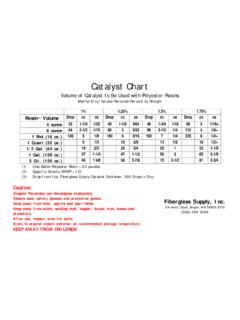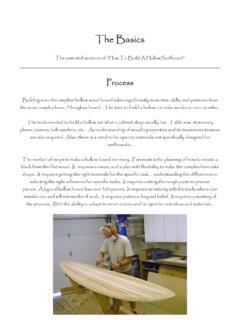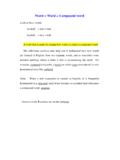Transcription of Glossary - Fiberglass Supply
1 Glossary Accelerator, A chemical used to increase the rate of cure of resin at room temperature. Acetone, A cleaning fluid used in RP/C context to remove uncured resin. A. Flammable Liquid. Additive, substances added to resin to impart specific performance qualities, such as ultraviolet inhibitors, fire retardant and air inhibitors. Adhesive Failure, A loss of bond that appears to be a separation at the adhesive /adherent interface. Air Dry, cure at room temperature without the application of heat or pressure. Air-Inhibited Resin, a resin whose surface will remain tacky to the touch after hardening because the oxygen in the air prevents completion of the reaction.
2 Alligatoring, Wrinkling of the gel coat. Antimony Trioxide, An additive used to impart fire retarding characteristics to a resin. Aramid, Aromatic polyamide fibers characterized by excellent flame-resistance, high-temperature, and electrical properties. Aramid fibers are used to achieve high-strength, high-modulus reinforcement in plastic composites. Areal Weight, a measurement unit consisting of the weight at a specified width times length, of the product. Woven fabrics are designated by weight per square yard. Mat by weight per square foot. Aspect Ratio, The ratio of length to width or diameter. Autoclave, A closed vessel that permits application of pressure and heat.
3 Auto-Ignition Temperature, The lowest temperature required to initiate or cause self-sustained combustion in the absence of a spark or a flame. Axial Winding, A type of filament winding in which the filaments are parallel to the axis. Bag Molding, A technique for forming plastic laminates or composites by means of air pressure, vacuum and/or heat in a flexible or semi-flexible bag or autoclave, usually in connection with a rigid die or mold Barcol Hardness, A determination of hardness of a polyester using a Barcol Impresser. Benzoyl Peroxide (BPO), The catalyst used in conjunction with aniline accelerators or where heat is used as an accelerator. Bi-Directional, An arrangement of the reinforcing fibers strands in which the strands are laid at right angles to each other, a directional pattern which gives maximum product strength in two planes.
4 1. Bias Fabric, A fabric in which warp and fill fibers are at an angle to the length. Biaxial Winding, A type of filament winding in which the helical band is laid in sequence, side by side, with no crossover of the fibers. Binder, Bonding resin applied to glass fibers to hold fibers in position. Blank, The foam core of a surfboard or sailboard that the shaper begins with. Bleeder Cloth, A layer of woven or non-woven material, not a part of the composite, that allows excess air and resin to escape during vacuum or pressure bagging. Bond Strength, As measured by load/bond area, the stress required to separate a layer of material from that to which it is bonded.
5 The amount of adhesion between bonded surfaces. Braiding, Weaving fibers into a tubular shape. Breather, A loosely woven material that does not come in contact with the resin but serves as a continuous path for release of entrapped air and resin during vacuum or pressure molding. Buckling (composite), A failure mode usually characterized by fiber deflection rather than breaking because of compressive action. Butt Joint, A joint in which parts are joined with no overlap. Carbon Fiber, An important reinforcing fiber known for light weight, high strength and high stiffness that is produced by pyrolysis of an organic precursor fiber in an inert atmosphere above 1800'F.
6 The material may also be graphitized by heat treated above 3000'F. Carcinogen, A substance that can promote the development of cancer. Catalyst In the common terminology of the reinforced composite industry, a catalyst is actually the initiator that causes the chemical reaction that turns a liquid polyester resin into a solid. The type of initiator employed depends upon the temperature at which the reaction will take place. Cavity, The space between matched molds (pressure molds) in which the laminate is formed. Also a term for a female mold. Centipoise, Measurement of viscosity as compared to water (1 centipoise). Chemical, Any element, chemical compound or mixture of elements and/or compounds.
7 Chemical Abstract Service Registry Number (CAS) - Identification number assigned to a chemical substance by the service. Many chemical data-base's use this number. Chemical Name, The scientific designation of a chemical in accordance with the nomenclature system developed by the International Union of Pure and Applied Chemistry or the Chemical Abstracts Service rules of nomenclature. 2. Chopped Strand, Continuous strand yam or roving cut up into uniform lengths, usually from 1/32" to 1/2" long. Chopper Gun, A special spray gun used for spray-up laminating which chops predetermined lengths of Fiberglass roving or strands, and deposits them together with catalyzed resin at the same time onto the mold surface.
8 Cloth, A fine weave of woven Fiberglass fabric. Cobalt, Used as the accelerator for Methyl Ethyl Ketone Peroxide catalyzed polyesters. Coefficient of Thermal Expansion, A material's fractional change in length for given unit change of temperature. Color Pigment, Dispersions ground coloring materials in a thick liquid, which are compatible with the resin system in which it will be used. When added to the resin, the pigment dispersions give it color Combustible, A solid, liquid or gas substance that will burn. Common Name, Any designation or identification such as a code name, code number, trade name, brand name or generic name used to identify a chemical other than by its chemical name.
9 Concentration, The amount of one substance in another substance. Container, Any bag, barrel, bottle, box, can cylinder, drum, reaction vessel, storage tank or the like that contains a hazardous chemical. Contingency Plan, A document setting out an organized, planned and coordinated course of action to be followed in case of a fire, explosion or release of hazardous waste that could threaten human health or the environment Corrosive, A substance, either liquid or solid, that can cause visible destruction or irreversible alterations in human skin at the site of contact. Or, RCRA defines "corrosive" as any chemical with a pH less than 2 or more than 12.
10 Commingled yarn, A hybrid yarn made with two types of materials intermingled in a single yarn; for example, thermoplastic filaments intermingled with carbon filaments to form a single yarn. Composite, Dissimilar materials laminated together to form a single structure, for example, resin, gel coat, glass. A material created from a fiber (or resin- reinforcement) and an appropriate matrix material in order to maximize specific performance properties. The constituents do not dissolve or merge completely but retain their identities as they act in concert. Compression Molding, A technique for molding thermoset plastics in which a part is shaped by placing the fiber and resin into an open mold cavity, closing the mold,, and applying heat and pressure until the material has cured or achieved its final form.






